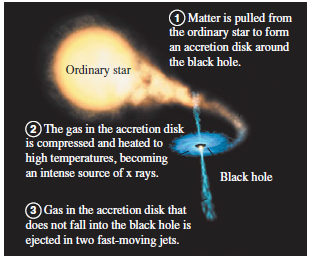Two stars, with masses M 1 and M 2 , are in circular orbits around their center
Question:
(a) Show that the ratio of the orbital radii of the two stars equals the reciprocal of the ratio of their masses€”that is,
(b) Explain why the two stars have the same orbital period, and show that the period T is given by T = 2Ï€(R1 + R2)3/2 / ˆšG(M1 + M2).
(c) The two stars in a certain binary star system move in circular orbits. The first star, Alpha, has an orbital speed of 36.0 km/s. The second star, Beta, has an orbital speed of 12.0 km/s. The orbital period is 137 d. What are the masses of each of the two stars?
(d) One of the best candidates for a black hole is found in the binary system called A0620-0090. The two objects in the binary system are an orange star, V616 Monocerotis, and a compact object believed to be a black hole (see Fig. 13.27). The orbital period of A0620-0090 is 7.75 hours, the mass of V616 Monocerotis is estimated to be 0.67 times the mass of the sun, and the mass of the black hole is estimated to be 3.8 times the mass of the sun. Assuming that the orbits are circular, find the radius of each object€™s orbit and the orbital speed of each object. Compare these answers to the orbital radius and orbital speed of the earth in its orbit around the sun.
Figure 13.27:
A binary star system in which an ordinary star and a black hole orbit each other. The black hole itself cannot be seen, but the x rays from its accretion disk can be detected.

Step by Step Answer:

University Physics with Modern Physics
ISBN: 978-0321696861
13th edition
Authors: Hugh D. Young, Roger A. Freedman, A. Lewis Ford





